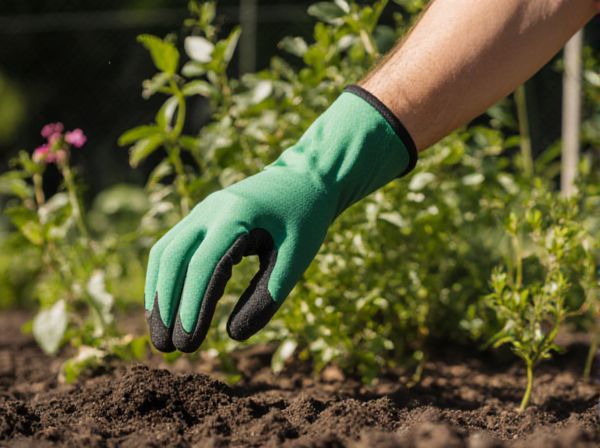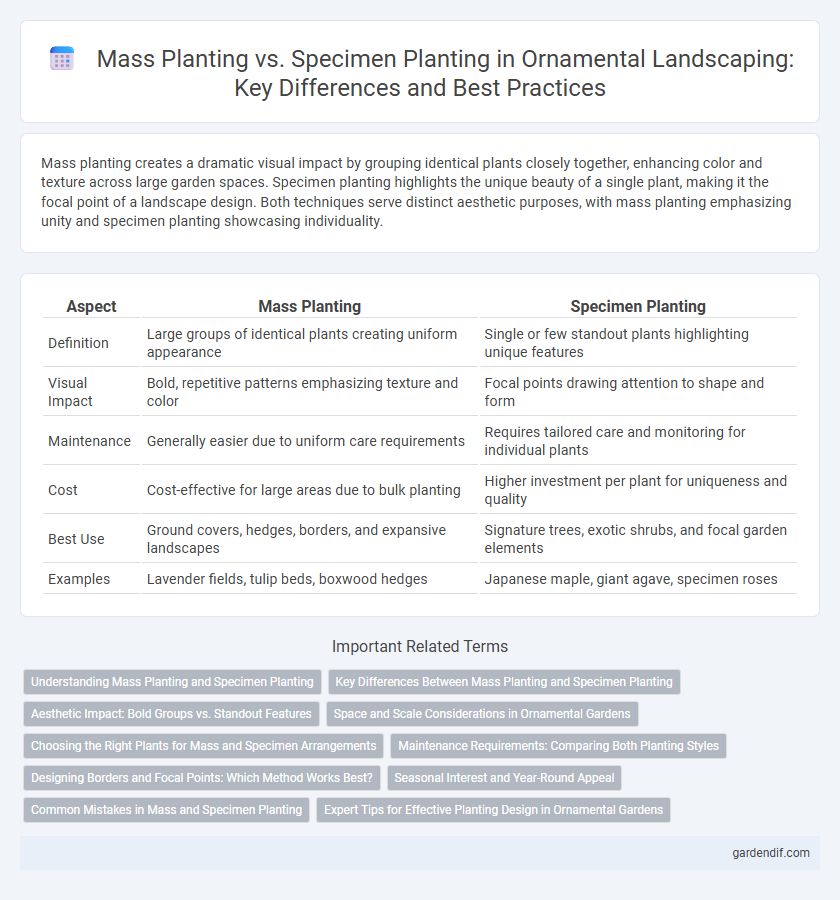
Mass Planting vs Specimen Planting Illustration
Mass planting creates a dramatic visual impact by grouping identical plants closely together, enhancing color and texture across large garden spaces. Specimen planting highlights the unique beauty of a single plant, making it the focal point of a landscape design. Both techniques serve distinct aesthetic purposes, with mass planting emphasizing unity and specimen planting showcasing individuality.
Table of Comparison
| Aspect | Mass Planting | Specimen Planting |
|---|---|---|
| Definition | Large groups of identical plants creating uniform appearance | Single or few standout plants highlighting unique features |
| Visual Impact | Bold, repetitive patterns emphasizing texture and color | Focal points drawing attention to shape and form |
| Maintenance | Generally easier due to uniform care requirements | Requires tailored care and monitoring for individual plants |
| Cost | Cost-effective for large areas due to bulk planting | Higher investment per plant for uniqueness and quality |
| Best Use | Ground covers, hedges, borders, and expansive landscapes | Signature trees, exotic shrubs, and focal garden elements |
| Examples | Lavender fields, tulip beds, boxwood hedges | Japanese maple, giant agave, specimen roses |
Understanding Mass Planting and Specimen Planting
Mass planting enhances visual impact by grouping numerous plants of the same species, creating a unified, bold display ideal for ground covers and borders. Specimen planting highlights individual plants, emphasizing their unique form, texture, or color within the landscape. Understanding these techniques enables designers to balance scale and focal points while maximizing ornamental value.
Key Differences Between Mass Planting and Specimen Planting
Mass planting involves grouping large quantities of the same plant species to create bold, uniform visual impact and enhance texture and color coherence. Specimen planting highlights individual plants as focal points, emphasizing their unique form, structure, and ornamental value. Key differences include scale, design purpose, and maintenance complexity, with mass planting favoring collective harmony and specimen planting showcasing distinctive beauty.
Aesthetic Impact: Bold Groups vs. Standout Features
Mass planting creates a bold visual impact by using repeated clusters of the same species, enhancing garden cohesion and color intensity. Specimen planting highlights unique plants as focal points, drawing attention to their distinct shapes, textures, or colors. Bold groups emphasize uniformity and rhythm, while standout features provide contrast and individual character within ornamental landscapes.
Space and Scale Considerations in Ornamental Gardens
Mass planting in ornamental gardens maximizes visual impact by using large groups of the same species, creating a uniform appearance that efficiently fills space and enhances scale. Specimen planting highlights individual plants, emphasizing unique forms and textures, ideal for smaller spaces or focal points where scale and spatial distinction are crucial. Selecting between mass and specimen planting depends on garden size, design intent, and the desired interplay of scale and spatial organization.
Choosing the Right Plants for Mass and Specimen Arrangements
Selecting the right plants for mass planting involves choosing varieties with consistent growth habits, vibrant colors, and hardiness to create uniform, impactful displays that thrive in group settings. Specimen planting demands unique, architecturally striking plants with distinct shapes, textures, or colors that serve as focal points and define the garden's character. Careful consideration of growth rate, maintenance needs, and site conditions ensures optimal performance for both mass and specimen arrangements in ornamental landscaping.
Maintenance Requirements: Comparing Both Planting Styles
Mass planting requires less intensive maintenance as uniform plant species simplify tasks like pruning, watering, and pest control, promoting efficient landscape management. Specimen planting demands higher maintenance, involving tailored care routines for individual plants to enhance their unique features and health. Evaluating water needs, fertilization schedules, and pruning frequency is essential for optimizing maintenance strategies in both styles.
Designing Borders and Focal Points: Which Method Works Best?
Mass planting creates a cohesive and visually impactful border by grouping identical plants to emphasize color and texture, making it ideal for large gardens and defined spaces. Specimen planting highlights unique or rare plants as focal points, drawing attention through individuality and structure, which enhances garden interest and variety. Combining both methods strategically can balance uniformity and distinctiveness, optimizing border design and focal point effectiveness in ornamental landscaping.
Seasonal Interest and Year-Round Appeal
Mass planting enhances seasonal interest by creating vibrant, uniform displays that highlight peak bloom periods and color changes, ensuring strong visual impact during specific times of the year. Specimen planting offers year-round appeal by showcasing unique textures, foliage, and structural forms that maintain aesthetic value beyond flowering seasons. Combining both approaches balances dynamic seasonal bursts with consistent garden interest throughout all months.
Common Mistakes in Mass and Specimen Planting
Common mistakes in mass planting include overcrowding plants, which restricts airflow and increases disease risk, and selecting species with incompatible growth rates or water needs. In specimen planting, errors often arise from poor site selection and insufficient space allowance, leading to stunted growth and reduced visual impact. Proper planning to match plant characteristics with environmental conditions is crucial to avoid these pitfalls in ornamental landscaping.
Expert Tips for Effective Planting Design in Ornamental Gardens
Mass planting enhances visual impact by grouping large numbers of the same species, creating bold color blocks and texture unity that thrive in well-drained, nutrient-rich soil. Specimen planting highlights individual plants with unique shapes or flowers, requiring strategic spacing and soil conditions tailored to the specific species to maximize their ornamental value. Expert garden designers recommend combining both techniques to balance striking focal points with harmonious mass displays, optimizing aesthetic appeal and ecological health in ornamental gardens.
Mass Planting vs Specimen Planting Infographic

 gardendif.com
gardendif.com